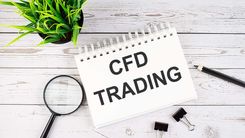

Vi använder cookies för att till exempel erbjuda support via livechatt och visa dig innehåll som vi tror att du är intresserad av. Om du accepterar att markets.com använder cookies klickar du på Godkänn.
CFD:er är komplexa instrument som innebär hög risk att du förlorar pengar snabbt på grund av hävstången. 75,2% av icke-professionella investerares konton förlorar pengar när de handlar med CFD:er hos den här leverantören. Du bör överväga om du förstår hur CFD:er fungerar och om du har råd att ta den höga risken att förlora dina pengar.
Tisdag Apr 11 2023 06:41

13 min
2. Forex CFD Trading Tip 2: Understand the key reasons for trading forex
3. Forex CFD Trading Tip 3: Make sure you understand CFDs thoroughly
4. Forex CFD Trading Tip 4: Make sure you understand what ‘pairs’ mean in forex CFD trading
5. Forex CFD Trading Tip 5: Understand the key risks of forex CFDs
6. Forex CFD Trading Tip 6: Get comfortable with losing money
7. Forex CFD Trading Tip 7: Understand the risks that come with leverage
8. Forex CFD Trading Tip 8: Understand how much capital you should be risking
9. Forex CFD Trading Tip 9: Know that educating yourself is crucial to success
10. Forex CFD Trading Tip 10: Practise trading before you do it for real

If you’ve come here looking for guidance on trading forex CFDs, you’re in the right place!
Forex CFDs can be lucrative, but it’s very important you understand how risky they can be if you don’t educate yourself thoroughly before you start trading.
Here are our 10 tips on trading forex CFDs for beginners:
The term forex is derived from the term ‘foreign exchange’. It’s where currencies are traded against each other.
It’s by far the biggest trading market in the world, with trillions of dollars in currencies being bought and sold every day.
The forex market is also known as the ‘market that never sleeps’, with major trading centres around the world keeping it open 24 hours a day, 5.5 days a week.
Typically, there are 3 reasons you might trade forex:
When you trade forex CFDs, you’re speculating on the markets. (And you don’t actually own the currencies you’re trading, which we’ll cover in the next point.)
CFD stands for ‘contract for difference’.
A CFD is a financial agreement between you and a registered CFD broker. When you enter into one of these contracts, you agree to exchange the difference in value between an asset’s price when the contract opens and when it closes.
In forex, that ‘price’ is the value of one currency against another.
So, let’s say you want to trade the US Dollar against the Euro.
When you open the contract, you can get 1.2 US dollars per Euro.
Over the next four hours, the exchange rate changes to 1.3 dollars per Euro.
That shift of 0.1 is your profit or loss, depending on how you trade.
(For a more comprehensive explanation, this guide here should help.)
It’s important to know that when you trade CFDs, you don’t actually ‘own’ the currencies. You’re essentially making a ‘speculation’ on whether the price will go up or down.
(Though CFD profits may be taxable, depending on where you’re based.)


Join the 100.000s that have made markets.com their home for trading. Learn about trading as you grow your portfolio.
More power in our platforms
Vi kan för närvarande inte ta emot kunder från ditt land. Om du har fått det här meddelandet av misstag kan du kontakta vår support på support@markets.com.
Kontakta support

All forex trades are done in ‘pairs’ of currencies. No matter which currencies you trade, you’re always trading one against the other.
For example, the currency pair EUR/USD is the combination of the Euro and the US Dollar. By trading this pair, a trader is effectively buying the Euro and selling the US Dollar.
Other example pairs are:
In all pairs, the first currency is known as the base currency, and the second is known as the quote currency.
In all forex trades, including forex CFDs, you trade the price of the base currency against the quote currency.
Beräkna ditt hypotetiska P/L (sammanlagda kostnader och avgifter) om du hade gjort en affär i dag.
Marknad

Instrument


Typ av konto
Riktning
Kvantitet
Beloppet måste vara lika med eller högre än
Filen ska vara mindre än
Beloppet måste vara en multipel av den lägsta lotsökningen
USD
EUR
GBP
CAD
AUD
CHF
ZAR
MXN
JPY
Värde
Courtage
Spread
Hävstångseffekt
Omräkningsavgift
Nödvändig marginal
Endags-swappar
Tidigare resultat är inte en tillförlitlig indikator på framtida resultat.
Alla positioner på instrument som är noterade i en annan valuta än din kontovaluta kommer också att omfattas av en omräkningsavgift vid positionsutgången.
There are 2 key risks that come when you trade forex CFDs:
This is a key psychological breakthrough that you need to make if you want to become a successful forex CFD trader.
You need to accept that you will suffer losing trades. Even the best, most profitable traders in the world lose money sometimes. And you will, too!
As Peter Lynch says, “There’s no shame in losing money on a stock. Everybody does it.”
Learning to cope with losses is something you need to do if you want to succeed in the long run.
One thing’s very clear, here: if you find the idea of losing money at all uncomfortable, do not trade.
That might sound harsh, but it’s the truth. If you can’t handle the idea of losing money sometimes, then trading simply isn’t for you.

Leverage, as we just mentioned, gives you the ability to enter larger forex trades using less capital upfront.
So, let’s say you use leverage of 20:1.
You choose to place a trade on GBP/USD that’s worth £10,000.
Because you’re using leverage of 20:1, you’ll only need £500 in initial capital to place the trade. (Plus your margin. You can find more information on margins here.)
This can allow you to access bigger trades with less capital, as you can see. This is particularly useful if you’re a beginner with less money to start with.
VERY IMPORTANT. When you use leverage, your profits and losses are based on the total value of the trade, NOT on the capital you put in.
You can lose more than your initial stake.
So, if you make the trade we just mentioned, your profits or losses are calculated based on the £10,000 size of the trade, not on the £500 you put in.
This means that if you lose 20% on the trade, your loss would be £2,000, more than the money you put in.
A key part of becoming a successful trader is making sure you understand how much of your capital you should risk.
Now, this isn’t law. In the end, it’s your choice how much capital you risk. This’ll come down to your own personal risk tolerance.
However, the British Financial Conduct Authority recommends that you never have more than 10% of your total capital in high-risk trades (which forex CFDs are).
So, if you have £20,000 in capital, it’s recommended you don’t have more than £2,000 of that wrapped up in forex CFDs (or any other high-risk trades).
Becoming a successful trader can be a lifetime’s work.
Take a look at any of the world’s most successful traders, and you’ll find that they put their results down to their study of the markets:
“The game taught me the game. And it didn’t spare me the rod while teaching.” - Jesse Livermore
“Risk comes from not knowing what you’re doing.” - Warren Buffett.
“Intellectual capital will always trump financial capital.” - Paul Tudor Jones
If you want to be a successful forex CFD trader, then you need to educate yourself on the markets. You might as well accept this now.
Before you place any forex CFD trades for real, it’s important you become 100% confident in the process.
You want to be completely sure you understand how to place a trade, how to set the size of your position, how to select whether you’re long or short, and how to set any stop losses or ‘take profits’.
At markets.com, we offer a full demo account complete with synthetic funds, so that you can practise placing CFD forex trades over and over again, without risking any real money.
Then, when you’re comfortable, you can start to trade for real.
Risk Warning and Disclaimer: This article represents only the author’s views and is for reference only. It does not constitute investment advice or financial guidance, nor does it represent the stance of the Markets.com platform. Trading Contracts for Difference (CFDs) involves high leverage and significant risks. Before making any trading decisions, we recommend consulting a professional financial advisor to assess your financial situation and risk tolerance. Any trading decisions based on this article are at your own risk.
Våra tillgångar
Visa merSenast
Visa alla
Söndag, 17 Augusti 2025

6 min

Söndag, 17 Augusti 2025

6 min

Söndag, 17 Augusti 2025

6 min
2. Forex CFD Trading Tip 2: Understand the key reasons for trading forex
3. Forex CFD Trading Tip 3: Make sure you understand CFDs thoroughly
4. Forex CFD Trading Tip 4: Make sure you understand what ‘pairs’ mean in forex CFD trading
5. Forex CFD Trading Tip 5: Understand the key risks of forex CFDs
6. Forex CFD Trading Tip 6: Get comfortable with losing money
7. Forex CFD Trading Tip 7: Understand the risks that come with leverage
8. Forex CFD Trading Tip 8: Understand how much capital you should be risking
9. Forex CFD Trading Tip 9: Know that educating yourself is crucial to success
10. Forex CFD Trading Tip 10: Practise trading before you do it for real